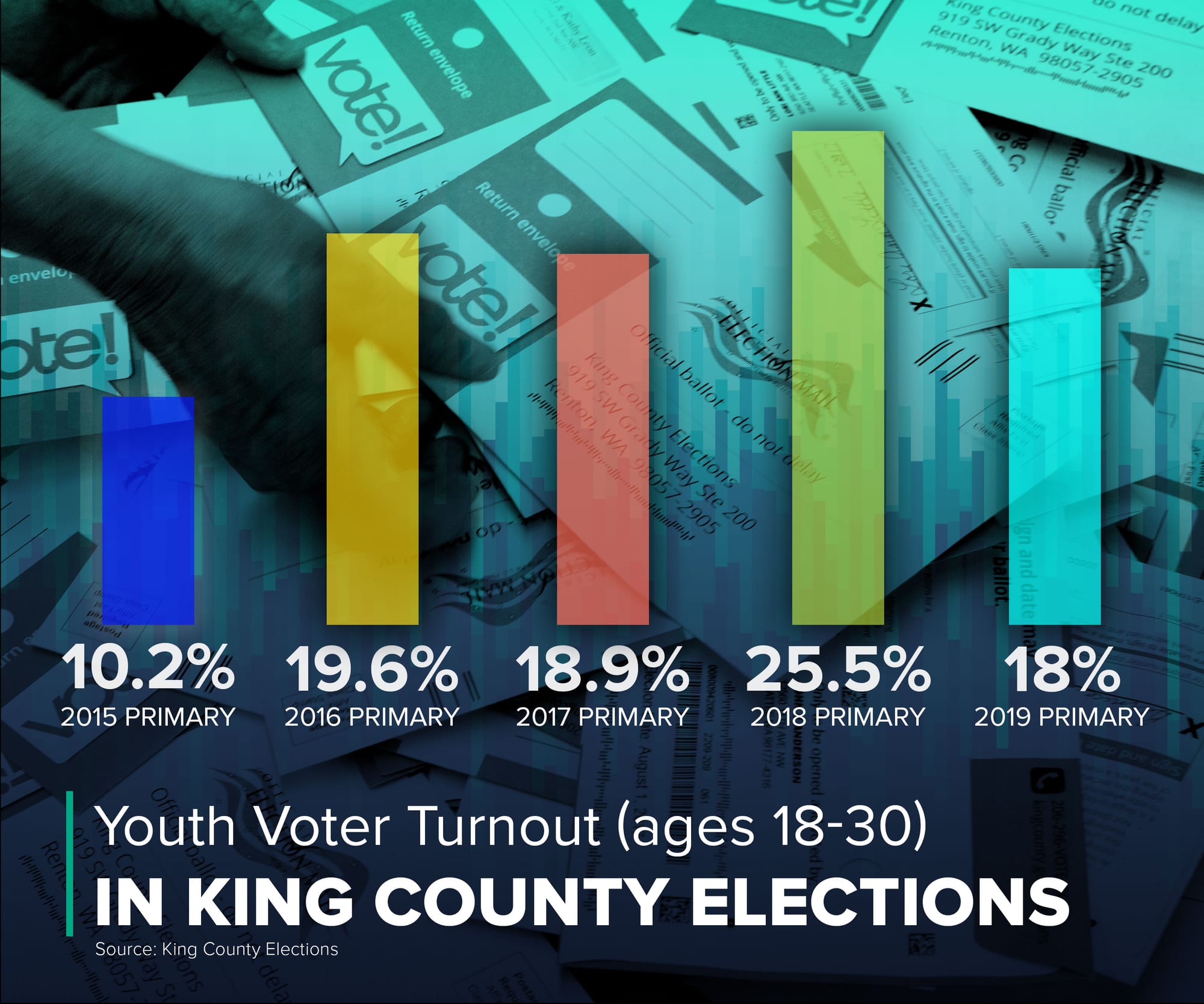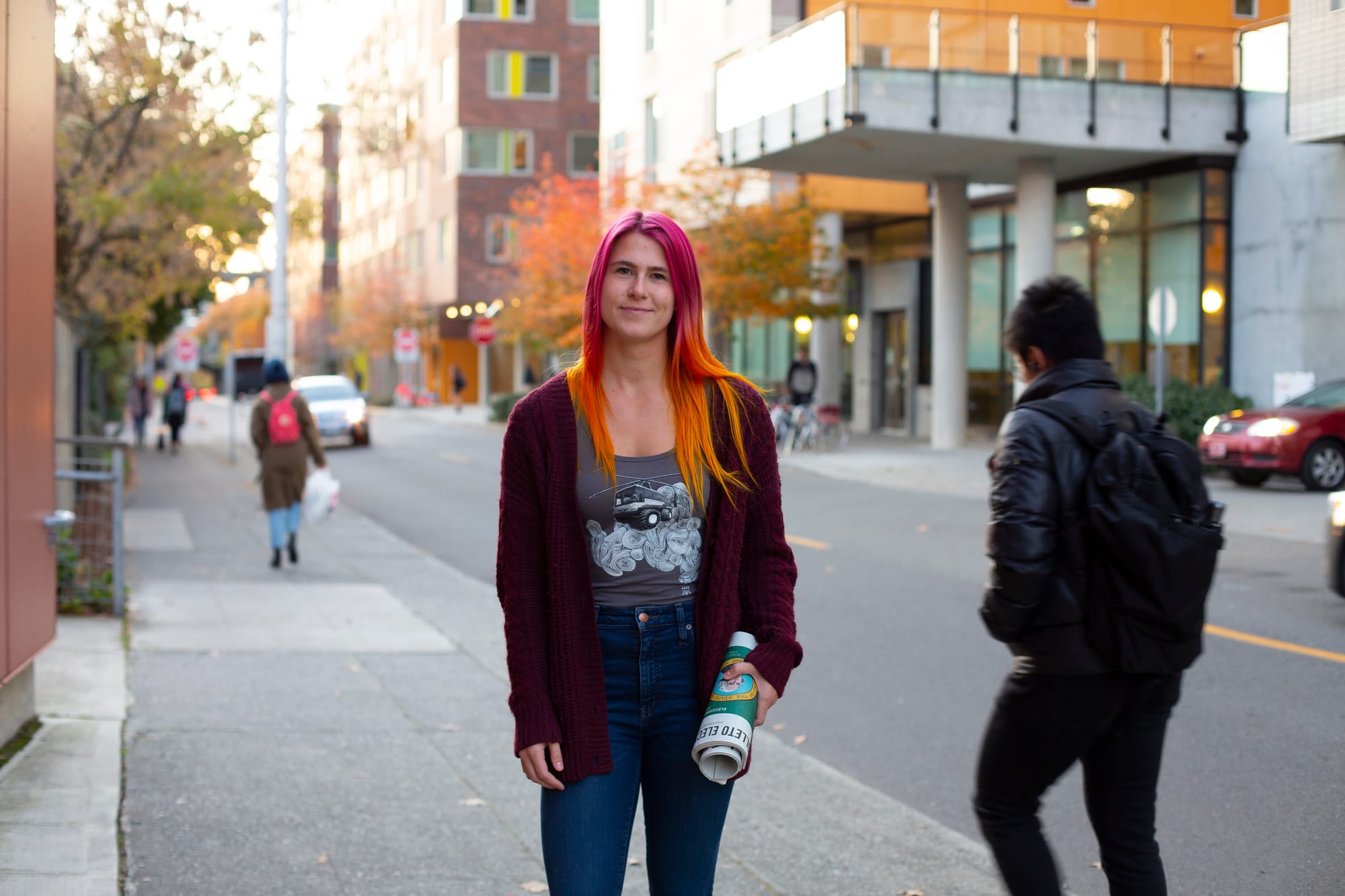Libby Watson aims to be approachable. That’s the whole idea behind having the affable 24-year-old show up on a college campus to talk to young voters, rather than sending someone twice her age.
On Halloween, Watson staffed a table at the University of Washington, handing out candy, voter pamphlets and information on how people can register to vote up until late Tuesday, the final day of voting in the Nov. 5 general election.
In so doing, Watson — who works for the youth voter outreach group The Washington Bus — usually also dispenses a bit of peer-to-peer advice.
“You wouldn’t let your grandparents choose who you date or what you wear,” Watson tells the young voters she encounters. “Why would you let them choose who represents you?”
For political campaigns, getting young people engaged in elections — particularly local ones — can sometimes feel like an uphill battle. Typically, far fewer young people vote, compared with people over 35.
But the 2018 midterm election saw some of those numbers begin to improve. Last fall across Washington state, the youngest voters — those 18 to 24 — showed up in much higher numbers than they did in 2010, the most recent comparable midterm election year.
Nearly 51% of Washington voters 18 to 24 cast ballots in November 2018, compared with about 41% in November 2010.
Turnout among voters ages 25 to 34 was also 6 percentage points higher in 2018 than it was eight years earlier.
The question now is: Without any high-profile congressional races on the ballot this year, will campaigns be able to still get young people to show up in high numbers?

Early signs point to yes, at least in King County. During the August primary election, where turnout is typically very low, a much higher percentage of young people voted this year than in 2015, the last local election cycle when similar types of races appeared on the ballot.
In King County, 18% of 18- to 30-year-old voters cast ballots in the August primary. That may not sound like much, but it’s a big jump from the 10% of registered voters in that age group who participated in the primary in 2015, the most comparable recent election year.
In fact, youth turnout for this year’s August primary nearly matches what it was in 2017, when a crowded, high-profile Seattle mayor’s race helped boost turnout locally.
While older voters still turned out in much higher numbers in August, campaign consultants say a surge among young voters and other groups that don’t regularly vote has significant power to influence an election's outcome.
“It helps on progressive issues, and for progressive candidates,” said Heather Weiner, a Democratic campaign consultant. That’s because older voters tend to vote more conservatively and vote more reliably — meaning that by default their votes are already factored into the political equation of many campaigns, she said.
In other words, “High turnout is good for more progressive issues and candidates, because those voters tend to be more infrequent voters,” Weiner said.
Looking at the local numbers for voter participation, a spike appears to have occurred after 2016.
Josh Amato, a former spokesperson for the state Republican Party who now works on digital marketing for political campaigns, said President Donald Trump’s election that year may have motivated more young people to stop sitting on the sidelines.
“That’s a real kick in the pants to get involved,” said Amato, who worked on John Kasich’s 2016 presidential campaign and is currently working with local candidates from both parties.
With the constant barrage of news coming out of the White House, Amato added, “I think that people are paying especially high attention to politics right now.” He noted a special election in April also had high participation for that type of election, which typically has low turnout.
Amato said it remains to be seen, however, if the recent level of engagement will continue. “Now we are in year three of constant outrage, which is tiring,” he said.
Yet, if young voters built up the habit of voting during the past few years, they may continue to show up for years to come, he said.
Derek Richards, the chair of the King County Young Democrats, said he thinks the number of younger candidates running in some of this year’s local races is piquing the interest of younger voters. As one of several examples, he mentioned Girmay Zahilay, who is challenging King County Councilmember Larry Gossett, as well as Abigail Doerr, who is challenging King County Councilmember Jeanne Kohl-Welles.
Zahilay is 32 and Doerr is 30; Kohl-Welles and Gossett, meanwhile, are both in their 70s.
“As young people see more people their age, they are more likely to turn out and vote,” Richards wrote in an email.
Young voters also are motivated by candidates who talk about issues such as climate change and affordable housing — “issues that directly affect our age group,” Richards wrote.
The rise of activism among teens, seen in the recent youth-led climate strike, could be fueling interest in voting even in a year when national issues aren’t on the ballot, said Jon Cantalini, executive director of the King County Republican Party. While last month’s global climate strike was inspired by Swedish teen Greta Thunberg, Cantalini said young conservatives who care about climate change are also rallying behind another young activist, 21-year-old environmentalist Benji Backer.
“More people who are younger are getting more involved,” said Cantalini, who is 23. “So when they are able to vote, at that point, they are in the mindset to do it more than they would be if we didn’t have these movements and groups led by younger people.”
Campaigns are taking note. That means getting on social media, posting Instagram stories and, increasingly, using texting to reach voters who may be more hesitant to pick up a random phone call, said Seferiana Day, a political consultant whose firm is working with Zahilay and several other young local candidates.
“I think phone banks are mostly a thing of the past, because most of the calls you get are spam,” Day said. “The technology is changing and it’s more in line with how younger folks want to engage. They are much more likely to read a text and maybe respond, whereas if you were to call someone you might not even be able to complete a sentence.”
Election officials, too, have tried to make voting easier and more accessible in recent years. Those efforts have included adding ballot drop boxes and pre-paying for postage on ballots, so voters don't have to worry about finding a stamp.
Still, even those who are working to engage young voters don’t necessarily expect 2018-style turnout in a year like 2019.

“Federal elections tend to be sexier,” said Richards of the King County Young Democrats, who noted that last year was about “taking back the House of Representatives so that Trump’s Republicans didn’t have a monopoly on all branches of government."
“I am not sure that we will reach that high of a turnout this year, though I do believe that we are going to see a higher turnout than we normally do from young people for these local elections,” Richards wrote in his email.
At least one young voter who didn’t return a ballot last year is planning to do so before Tuesday. Ruth Diaz, a 20-year-old senior at the University of Washington, stopped by Watson’s information table on Halloween and picked up a voter pamphlet to help her get up to speed on the issues and candidates.
Last year, Diaz was busy with midterms in November and wasn’t able to keep up with what was happening in the 2018 elections, she said. This year, after taking classes that discuss politics as part of her coursework in international studies and geography, she said she wants to be more involved.
“I think for me it is just about understanding what is happening in my community,” Diaz said. “I want to be doing something more.”
She said she’s motivated to vote for candidates who are working to reduce gentrification among minority groups. She also is looking to help elect more people of color to local offices — “more people who understand us,” she said.
Watson, who is the colleges and community engagement coordinator at The Washington Bus, said she hears those kind of sentiments often when she helps register new voters and reminds people how to return their ballots.
“Because of all the uptick in interest by young people, with the March for Our Lives and the climate marches, I think it is generally getting easier to get people engaged in these off-year elections,” Watson said. “I think the interest is still really high, and people are realizing the potential they have to make a difference and get their voices heard.”



